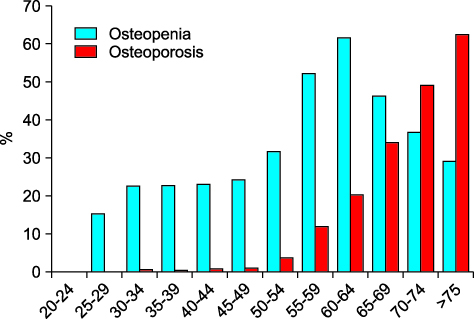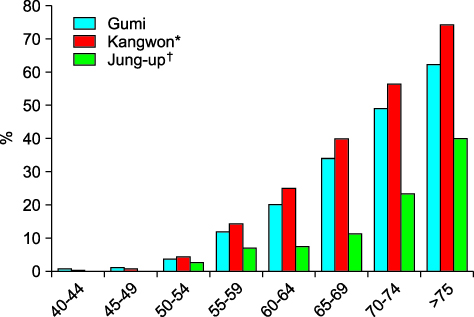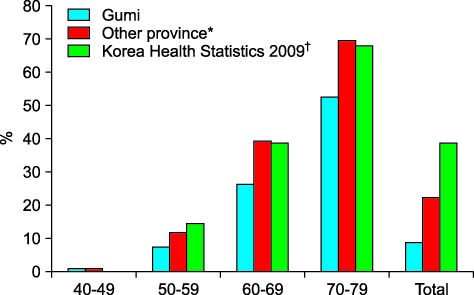J Korean Soc Menopause.
2012 Apr;18(1):28-35.
Prevalence of Osteoporosis and Osteopenia in Women in Gumi Gyeongbuk Province
- Affiliations
-
- 1Department of Obstetrics and Gynecology, College of Medicine, Soonchunhyang University Gumi Hospital, Gumi, Korea.
- 2Department of Obstetrics and Gynecology, College of Medicine, Soonchunhyang University Bucheon Hospital, Bucheon, Korea. heeobgy@schmc.ac.kr
- 3Department of Family Medicine, College of Medicine, Soonshunhyang University, Gumi Hospital, Gumi, Korea.
Abstract
OBJECTIVES
The aim of the present study was to determine the prevalence of osteopenia and osteoporosis in women aged 20 years and older in Gumi province.
METHODS
We recruited a total of 2,347 women aged 20 years and older in Gumi province who visited the health care center in Soonchunhyang University Gumi hospital from January 2010 to December 2011. The bone mineral densities in the calcaneus were measured by an ultrasound bone densitometry. Osteoporosis and osteopenia were defined by World Health Organization criteria. Age-specific prevalence of osteoporosis and osteopenia in Gumi province were determined and compared with the prevalence of osteoporosis and osteopenia from other provinces within Korea. The prevalence of each was described by %.
RESULTS
Age-specific prevalence of osteoporosis was less than 2% in women younger than 50 years but it rapidly increased in those older than 55 years and up to about 50% in women older than 70 years. The prevalence of osteoporosis in women in Gumi province was lower than that of Kangwon province. However, its results were higher than Jung-up province. In addition, the prevalence of osteoporosis in women in Gumi province was lower than other provinces including: Gang-hwa, Chun-cheon, Chung-ju, Jungnang and Gangseo in Seoul, Korea Health Statistics 2009.
CONCLUSION
The age-specific prevalence of osteoporosis in women in Gumi province increased with ages, especially in those older than 55 years. Also, the prevalence of osteoporosis in women in Gumi province was lower than Kangwon and other provinces within Korea as stated by Korea Health Statistics 2009. However, its results were higher than Jung-up province.
Keyword
MeSH Terms
Figure
Reference
-
1. NIH Consensus Development Panel on Osteoporosis Prevention, Diagnosis, and Therapy. Osteoporosis prevention, diagnosis, and therapy. JAMA. 2001. 285:785–795.2. Peck WA. The world health burden of osteoporosis: today and the future. In : The 4th International Symposium on Osteoporosis; 1993 Mar 27-31; Hong Kong. National Osteoporosis Foundation.3. Population projections and summary indicators for Korea. Korean Statistical Information Service. 2011. cited by 2012 Jan 3. Seoul: Statistics Korea;Available from: http://kosis.kr/abroad/abroad_01List.jsp?parentId=A.4. Summary of census population. Korean Statistical Information Service. 2005. cited by 2009 Jan 3. Seoul: Statistics Korea;Available from: http://kosis.kr/abroad/abroad_01List.jsp?parentId=A.5. Grampp S, Genant HK, Mathur A, Lang P, Jergas M, Takada M, et al. Comparisons of noninvasive bone mineral measurements in assessing age-related loss, fracture discrimination, and diagnostic classification. J Bone Miner Res. 1997. 12:697–711.6. Jeon GH, Kim SR, Kim SH, Chae HD, Kim CH, Kang BM. Prevalence of osteoporosis and osteopenia in women in Kangwon province: geographical comparison study. Korean J Bone Metab. 2008. 15:135–141.7. Kim CH, Kim YI, Choi CS, Park JY, Lee MS, Lee SI, et al. Prevalence of osteoporosis in Jung-Up district, Korea. Korean J Bone Metab. 1997. 4:65–71.8. Choi JY, Han SH, Shin AS, Shin CS, Park SK, Cho SI, et al. Prevalence and risk factors of osteoporosis and osteopenia in Korean women: cross-sectional study. J Korean Soc Menopause. 2008. 14:35–49.9. Sang JH, Park HM. Prevalence of chronic diseases in postmenopausal Korean women : 2009 Korean National Health and Nutrition Examination Survey. 2011. In : The 97th Annual Congress of Korean Society of Obstetrics and Gynecology; Seoul. Korean Society of Obstetrics and Gynecology;–144.10. Cooper C. Epidemiology of osteoporosis. Osteoporos Int. 1999. 9:Suppl 2. S2–S8.11. Kim SW, Chung YK. Long term follow-up of osteoporotic vertebral fractures according to the morphologic analysis of fracture pattern. J Korean Soc Spine Surg. 2000. 7:611–617.12. Riggs BL, Melton LJ 3rd. Involutional osteoporosis. N Engl J Med. 1986. 314:1676–1686.13. Peck WA, Burckhardt P, Christiansen C, Fleisch HA, Genant HK, Gennari C, et al. Consensus development conference: diagnosis, prophylaxis, and treatment of osteoporosis. Am J Med. 1993. 94:646–650.14. National Osteoporosis Foundation. Fast facts on osteoporosis. 2005. Washington, DC: National Osteoporosis Foundation.15. Vogel JM, Wasnich RD, Ross PD. The clinical relevance of calcaneus bone mineral measurements: a review. Bone Miner. 1988. 5:35–58.16. Looker AC, Orwoll ES, Johnston CC Jr, Lindsay RL, Wahner HW, Dunn WL, et al. Prevalence of low femoral bone density in older U.S. adults from NHANES III. J Bone Miner Res. 1997. 12:1761–1768.17. Tenenhouse A, Joseph L, Kreiger N, Poliquin S, Murray TM, Blondeau L, et al. Estimation of the prevalence of low bone density in Canadian women and men using a population-specific DXA reference standard: the Canadian Multicentre Osteoporosis Study (CaMos). Osteoporos Int. 2000. 11:897–904.18. Smeets-Goevaers CG, Lesusink GL, Papapoulos SE, Maartens LW, Keyzer JJ, Weerdenburg JP, et al. The prevalence of low bone mineral density in Dutch perimenopausal women: the Eindhoven perimenopausal osteoporosis study. Osteoporos Int. 1998. 8:404–409.19. Boyanov M, Popivanov P. Prevalence of low forearm bone density in a Bulgarian female referral population. Osteoporos Int. 2002. 13:288–295.20. Iki M, Kagamimori S, Kagawa Y, Matsuzaki T, Yoneshima H, Marumo F. Bone mineral density of the spine, hip and distal forearm in representative samples of the Japanese female population: Japanese Population-Based Osteoporosis (JPOS) Study. Osteoporos Int. 2001. 12:529–537.21. Limpaphayom KK, Taechakraichana N, Jaisamrarn U, Bunyavejchevin S, Chaikittisilpa S, Poshyachinda M, et al. Prevalence of osteopenia and osteoporosis in Thai women. Menopause. 2001. 8:65–69.22. Li N, Ou P, Zhu H, Yang D, Zheng P. Prevalence rate of osteoporosis in the mid - aged and elderly in selected parts of China. Chin Med J (Engl). 2002. 115:773–775.23. Xu SZ, Zhou W, Mao XD, Xu J, Xu LP, Ren JY. Reference data and predictive diagnostic models for calcaneus bone mineral density measured with single-energy X-ray absorptiometry in 7428 Chinese. Osteoporos Int. 2001. 12:755–762.24. Lee WS, Park HM, Bae DH. Prevalence of osteoporosis in Korean women. J Korean Soc Menopause. 2003. 9:339–346.
- Full Text Links
- Actions
-
Cited
- CITED
-
- Close
- Share
- Similar articles
-
- Prevalence of Osteoporosis Based on Bone Density Measurement in Korean Women
- Prevalence of Osteoporosis of Korean Women based on Bone Mineral Density of the radius and effect of menopause on osteoporosis
- The Effect of Tibolone on Bone Mineral Density in Postmenopausal Women with Osteopenia or Osteoporosis
- Evaluation of Simple Tool as a Screening Test for Osteoporosis and Osteopenia in Korean Postmenopausal Women
- Prevalence Rate of Osteoporosis in the Patients Who Underwent Posterior Instrumentation of Degenerative Lumbar Spine




